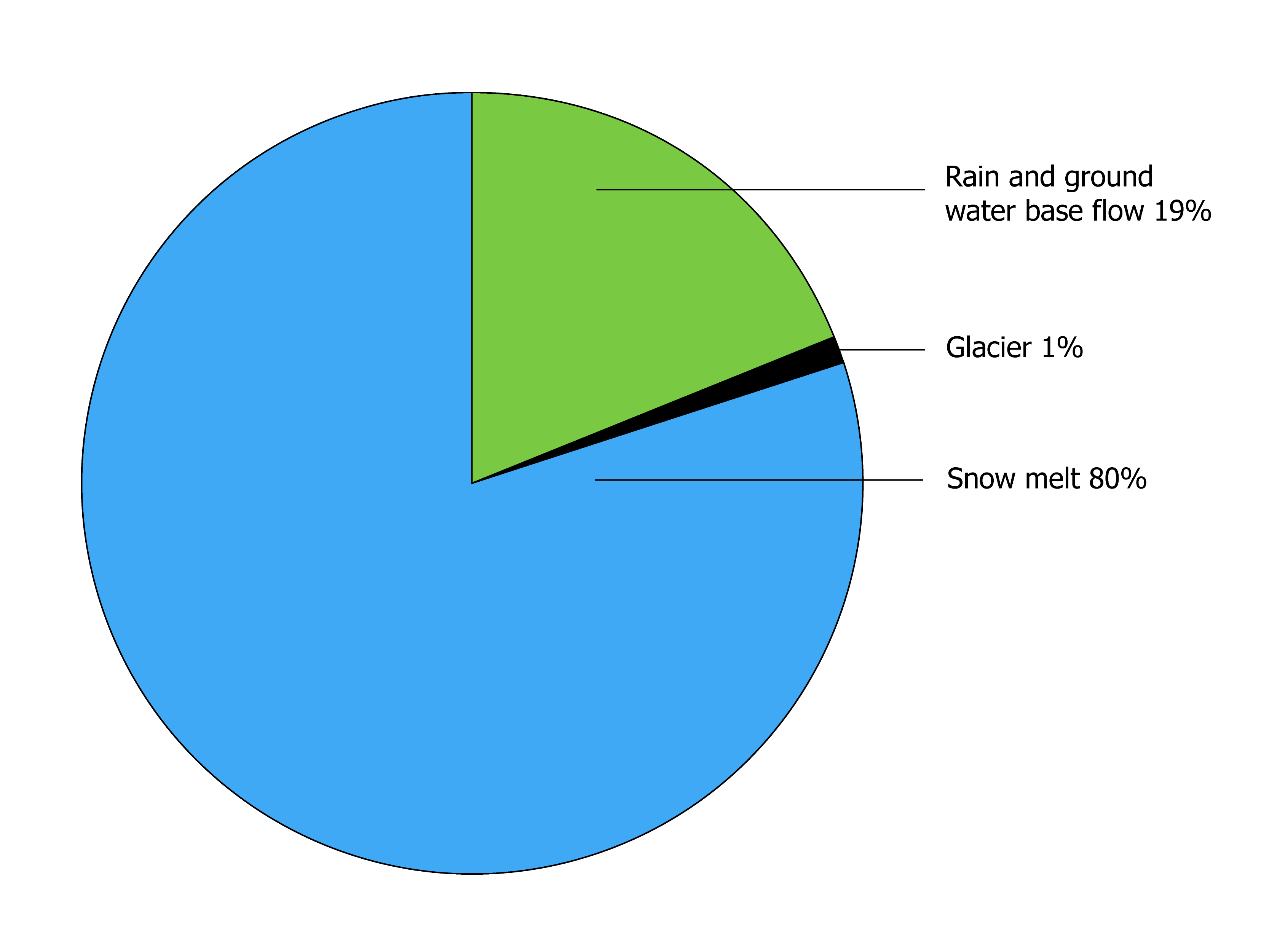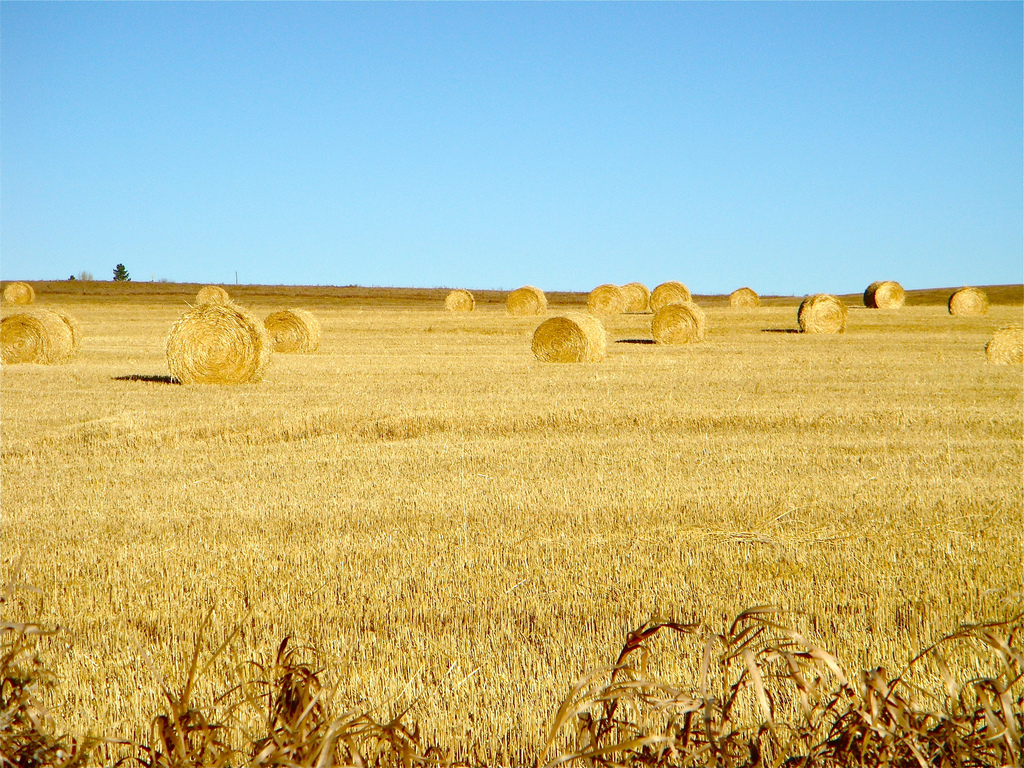Converging factors affecting the Bow River basin
 The Alberta Water Nexus Project pilot focuses on the Bow River basin, one of four sub-basins located in the greater South Saskatchewan River basin (SSRB). The Bow River basin covers over 25,000 square kilometres, making up about 23% of the SSRB’s drainage area. The basin’s water journey begins in the Rocky Mountains, where snow and glacial-melt feed the headwaters. From the mountains water flows into Bow Lake which is also the beginning of the Bow River. The Bow River flows through Banff National Park into foothills and continues through grasslands before joining the Oldman River, where together the two rivers form the South Saskatchewan River, 80 kilometres upstream of Medicine Hat.
The Alberta Water Nexus Project pilot focuses on the Bow River basin, one of four sub-basins located in the greater South Saskatchewan River basin (SSRB). The Bow River basin covers over 25,000 square kilometres, making up about 23% of the SSRB’s drainage area. The basin’s water journey begins in the Rocky Mountains, where snow and glacial-melt feed the headwaters. From the mountains water flows into Bow Lake which is also the beginning of the Bow River. The Bow River flows through Banff National Park into foothills and continues through grasslands before joining the Oldman River, where together the two rivers form the South Saskatchewan River, 80 kilometres upstream of Medicine Hat.
Location of major bodies of water and resource distribution
The Bow River basin is comprised of a diverse range of water bodies, all of which significantly affect the basin’s water, food, and energy Nexus . These water bodies are vital in maintaining the basin’s ecosystem viability and support numerous economic activities in the region.
The basin’s lakes, such as Lake Louise, Lake Minnewanka, and Moraine Lake, as well as the numerous reservoirs including Newell Reservoir, Ghost Lake Reservoir, Glenmore Reservoir, and Spray Lakes Reservoir are also important. These lakes and reservoirs are used for a variety of activities such as power generation, irrigation, drinking water production, and recreation. Connected mountain and prairie tributaries, such as the Sheep, Elbow, and Highwood Rivers, as well as many smaller irrigation reservoirs, also contribute to the basin’s diverse water resources.
Primarily fed by snow melt, rainfall, and glacial melt, the Bow River has significant flow variations throughout the year. During the months of spring and summer snow melt and rainfall typically leads to higher river flows, whereas in fall and winter the river experiences reduced flows. During reduced river flows water resources are derived from groundwater. However, on an annual basis, groundwater only contributes around 20% of the Bow River’s flow.
 |
| Figure 2: Water supply in the Bow River basin (Data source: BRBC) |
Nexus factors in the Bow River basin
Numerous sectors compete for the Bow River basin’s water resources. In 2010, total annual surface and groundwater allocations in the basin reached approximately 2,801 million cubic meters, with 70% allocated for agriculture and 18% for municipal use, which also includes significant commercial and industrial activity within municipal licences. The remaining 12% of water allocations were split between commercial and industrial activities, water management, habitat management and other uses. It is important to note, however, that not all allocated volumes are necessarily consumed. In some cases, significant volumes are used for non-consumptive purposes and are returned to the watershed as ‘return flows’.
Agriculture
 |
| “Fall Harvest” by JMacPherson s licenced under CC BY 2.0 |
Agriculture is the Bow River basin’s largest fresh-water consumer, using water primarily for irrigation purposes. Major agricultural activities in the basin include crop production and raising livestock. In terms of crop production, wheat, barley, and oil seed farming represent the majority of the basin’s farming activities. A range of other crops including vegetables, potatoes, silage corn, and alfalfa are also produced in the basin. One of the most important livestock farming activities in the basin is raising cattle, including bulls, dairy and beef cows, calves, and slaughter steers and heifers. Moving forward, a sustainable and competitive agriculture industry will be required to meet the needs of the basin’s growing population.
Additionally, as one of the world’s largest food exporters, Canada is expected to play an even greater role in meeting global food demand, anticipated to increase significantly, due to population growth and changing diets. As part of this, the Bow River basin will likely make a significant contribution to satisfying future food demand, particularly due to its abundant arable land. Ensuring sufficient water availability for agricultural use, without neglecting the needs of other key sectors in the basin, will require careful consideration by decision-makers*.
Municipal
 |
| City of Calgary from the Bow River – Alberta WaterPortal |
With more than one million people living in the Bow River basin it’s no surprise municipal use represents the basin’s second largest water allocation. This water is used to meet the needs of the basin’s numerous urban, rural, and First Nations’ settlements.
Major population centres in the basin include the City of Calgary and the City of Airdrie, as well as several rural municipalities, such as Rocky View County and the Municipal District of Foothills. First Nations’ settlements also make up significant population centres, such as the Stoney Nation and Siksika Nation reserves. The City of Calgary is by far the largest municipal water user, withdrawing over 176,000 million litres (ML) of water in 2014. With the population of Calgary estimated to reach 1.4 million by 2041, ensuring the availability of sufficient water quality and quantity will pose a major challenge. Additionally, with further municipal growth planned in other parts of the Bow River basin, balancing the water demands of new municipalities with the water needs of other sectors will require decision-makers to manage significant trade-offs.
Industrial
 |
| “Machine in the Garden” by elleenmak is licenced under CC BY 2.0 |
Industrial users in the Bow River basin require water for a wide range of industrial activities. A significant non-consumptive water user is the power generation industry, which uses water to produce hydroelectricity. A significant consumptive industrial water user, on the other hand, is the petroleum sector, which uses water for oilfield injection, including enhanced oil recovery and hydraulic fracturing, as well as other petroleum related activities that support production from thousands of oil and gas wells in the basin. Other industrial water uses in the basin include cooling, such as for thermal power generation and air conditioning, as well as fertilizer production. A significant portion of the water that is needed for these activities is returned to the basin as a return flow, rather than consumptive use.
Future industrial developments in the region will face stiff competition for water resources from industrial sectors already present in the basin. This is particularly important for the petroleum sector as growing energy demand, combined with advances in technology, leads to increased oil and gas development in the region. Even though current water use by the petroleum sector is less than 1% of allocations in the basin (Figure 2), this share can be expected to increase in the future. For example, water intensive practices such as hydraulic fracturing will likely play a significant role in future oil and gas development in the region, particularly as conventional production of oil and gas continues to decline.
 |
| Figure 2: Water consumption in the Bow River Basin (Data source: BRBC) |
To achieve continued economic growth in the Bow River basin, the needs of sectors competing for water will need to be carefully considered. There are significant trade-offs to be made, particularly since Alberta Environment no longer accepts applications for new water allocations in many of the SSRB’s sub-basins, including the Bow River basin. Effectively managing these trade-offs is an integral part of the Nexus concept in the Bow River basin, a concept that cannot be ignored if the region wants to realise a vision of long term environmental, social and economic leadership.
*For the purposes of the Alberta Water Nexus Project pilot, the ultimate decision-maker is the Director at Alberta Environment and Parks (AEP), since this person issues approvals and/or licences under Alberta’s Environmental Protection and Enhancement Act and Water Act. However, the general public and numerous other actors in the basin, such as municipalities, businesses, and watershed groups such as the Bow River Basin Council (BRBC), help inform decisions made by the Director. As a result, we use the term ‘decision-makers’ to capture all actors who contribute to decisions that affect the basin’s water resources.
Sources
[1] “Profile of the Bow River Basin.” Bow River Basin Council. Accessed November 2015. http://brbc.ab.ca/brbc-documents/…/66-web-based-state-of-the-watershed-2010-booklet
[2] Ibid.
[3] Ibid.
[4] “Hydrology.” Bow River Basin Council. Accessed November 2015. http://brbc.ab.ca/brbc-documents/…/66-web-based-state-of-the-watershed-2010-booklet
[5] Ibid.
[6] “Water Allocations and Use in the Bow River Basin.” Bow River Basin Council. Accessed November 2015. http://brbc.ab.ca/brbc-documents/…/66-web-based-state-of-the-watershed-2010-booklet
[7] bid.
[8] “Alberta Crop Production Statistics.” Alberta Agriculture and Forestry. Accessed November 2015. http://www1.agric.gov.ab.ca/$department/deptdocs.nsf/all/sdd12061
[9] “Agriculture Statistics Factsheet.” Alberta Government. Accessed November 2015. http://www1.agric.gov.ab.ca/$department/deptdocs.nsf/all/sdd12807
[10] “Better by the Drop: Revealing the Value of Water in Canadian Agriculture.” Schreier, H. & Wood, C. Accessed November 2015. http://www.cwn-rce.ca/assets/resources/pdf/Blue-Economy-Initiative/BEI-Better-by-the-Drop-report-EN-web.pdf
[11] “Profile of the Bow River Basin.” Bow River Basin Council. Accessed November 2015. http://brbc.ab.ca/brbc-documents/…/66-web-based-state-of-the-watershed-2010-booklet
[12] “Hydrology.” Bow River Basin Council. Accessed November 2015. http://brbc.ab.ca/brbc-documents/…/66-web-based-state-of-the-watershed-2010-booklet
[13] “2014 Water Report.” The City of Calgary. Accessed November 2015. http://www.calgary.ca/_layouts/cocis/DirectDownload.aspx?target=http%3a%2f%2fwww.calgary.ca%2fUEP%2fWater%2fDocuments%2fWater-Documents%2fWater-Report.pdf&noredirect=1&sf=1
[14] “Regional Water and Wastewater Servicing Masterplan.” CH2M Hill on behalf of the Calgary Regional Partnership. Published 2014. Link: http://calgaryregion.ca/dam/Website/reports/General/Regional-servicing-and-CMP-Implementation/Regional-Water-and-Wastewater-Servicing-Master-Plan/Regional%20Water%20and%20Wastewater%20Servicing%20Master%20Plan.pdf
[15] “Bow River Basin State of the Watershed Summary 2010.” Bow River Basin Council. Published 2010. Link: http://www.brbc.ab.ca/brbc-documents/publications/66-web-based-state-of-the-watershed-2010-booklet
[16] “Our Water, Our Future – A Conversation with Albertans.” Alberta Government. Accessed November 2015. http://aep.alberta.ca/water/water-conversation/documents/WaterFuture-ConversationAlbertans-Feb2013.pdf
[17] “ST98-2015: Alberta’s Energy Reserves 2014 and Supply/Demand Outlook 2015-2024.” Alberta Energy Regulator. Accessed January 2016. www.aer.ca/documents/sts/ST98/ST98-2015.pdf
[18] “Water Allocations and Use in the Bow River Basin.” Bow River Basin Council. Accessed January 2016. http://wsow.brbc.ab.ca/index.php?option=com_content&view=article&id=86&Itemid=84
[19] “Water Rights and Property Rights.” Environmental Law Centre. Accessed November 2015. http://www.elc.ab.ca/Content_Files/Files/Water_Rights.pdf
